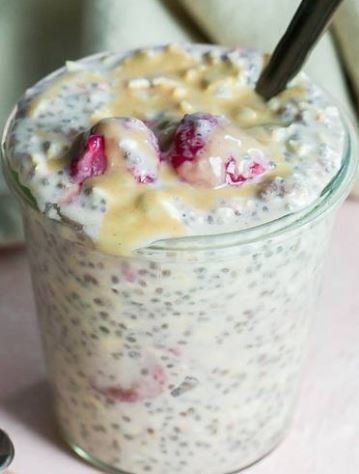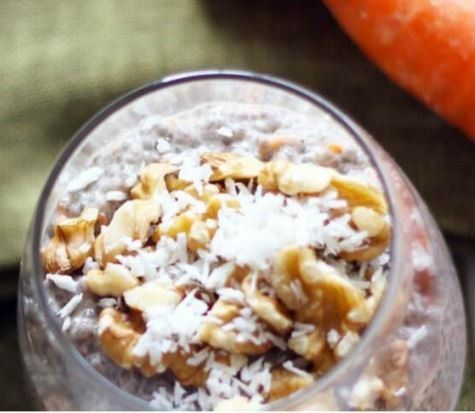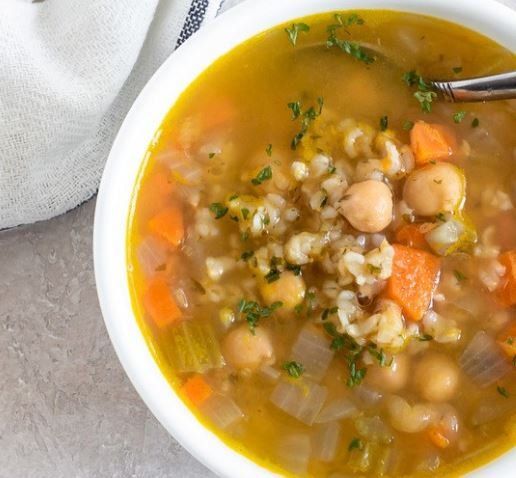Sluggish Metabolism? Eat This . . .
You may feel tired, cold or that you've gained weight . . .

Maybe your digestion seems a bit more “sluggish”.
You may be convinced that your metabolism is slow.
Why does this happen? Why do metabolic rates slow down?
What can slow my metabolism?
Metabolism includes all of the biochemical reactions in your body that use nutrients and oxygen to create energy. And there are lots of factors that affect how quickly (or slowly) it works, i.e. your “metabolic rate” (which is measured in calories).
But don't worry – we know that metabolic rate is much more complicated than the old adage “calories in calories out”! In fact it's so complicated I'm only going to list a few of the common things that can slow it down.
Examples of common reasons why metabolic rates can slow down:
- low thyroid hormone
- your history of dieting
- your size and body composition
- your activity level
- lack of sleep
I will briefly touch on each one below and I promise to give you better advice than just to “eat less and exercise more”.
Low thyroid hormones
Your thyroid is the master controller of your metabolism. When it produces fewer hormones your metabolism slows down. The thyroid hormones (T3 & T4) tell the cells in your body when to use more energy and become more metabolically active. Ideally it should work to keep your metabolism just right. But there are several things that can affect it and throw it off course. Things like autoimmune diseases and mineral deficiencies (e.g. iodine or selenium) for example.
Tip: Talk with your doctor about having your thyroid hormones tested, or consult with your Nutritionist about Darkfield Microscopy testing.
Your history of dieting
When people lose weight their metabolic rate often slows down. This is because the body senses that food may be scarce and adapts by trying to continue with all the necessary life functions and do it all with less food.
While dieting can lead to a reduction in amount of fat it unfortunately can also lead to a reduction in the amount of muscle you have. As you know more muscle means faster resting metabolic rate.
Tip: Make sure you're eating enough food to fuel your body without overdoing it.
Your size and body composition
In general, larger people have faster metabolic rates. This is because it takes more energy to fuel a larger body than a smaller one.
However, you already know that gaining weight is rarely the best strategy for increasing your metabolism.
Muscles that actively move and do work need energy. Even muscles at rest burn more calories than fat. This means that the amount of energy your body uses depends partly on the amount of lean muscle mass you have.
Tip: Do some weight training to help increase your muscle mass.
Which leads us to...
Your activity level
Aerobic exercise temporarily increases your metabolic rate. Your muscles are burning fuel to move and do “work” and you can tell because you're also getting hotter.
Even little things can add up. Walking a bit farther than you usually do, using a standing desk instead of sitting all day, or taking the stairs instead of the elevator can all contribute to more activity in your day.
Tip: Incorporate movement into your day. Also, exercise regularly.
Lack of sleep
There is plenty of research that shows the influence that sleep has on your metabolic rate. The general consensus is to get 7-9 hours of sleep every night.
Tip: Try to create a routine that allows at least 7 hours of sleep every night. If you have difficulty falling or staying asleep, contact me to discuss natural sleep solutions.
Eat This . . .
Chocolate Chia Seed Pudding (serves 4)
Ingredients:
- ½ cup Brazil nuts
- 2 cups water
- nut bag or several layers of cheesecloth (optional)
- ½ cup chia seeds
- ¼ cup unsweetened cacao powder
- ½ teaspoon ground cinnamon
- ¼ teaspoon sea salt
- 1 tablespoon maple syrup
Directions:
- Blend Brazil nuts in water in a high-speed blender until you get smooth, creamy milk. If desired, strain it with a nut bag or several layers of cheesecloth.
- Add Brazil nut milk and other ingredients into a bowl and whisk until combined. Let sit several minutes (or overnight) until desired thickness is reached.
Serve & Enjoy!
Tip: Makes a simple delicious breakfast or dessert topped with berries.
References:
http://www.precisionnutrition.com/metabolic-damage
http://www.precisionnutrition.com/thyroid-and-testing
http://www.precisionnutrition.com/all-about-energy-balance
https://authoritynutrition.com/6-mistakes-that-slow-metabolism/
https://authoritynutrition.com/10-ways-to-boost-metabolism/
http://summertomato.com/non-exercise-activity-thermogenesis-neat
Recent Posts

Vitamin C is an essential nutrient that promotes healing in every situation of poor health. Benefits Include: activates growth and repair in tissues boosts immune system aids in synthesis of collagen for healthy skin and mucous membranes vital to the bodys healing process Unlike some animals, humans are unable to synthisize vitamin C endogenously, so it's an essential dietary component. Best Sources Include: strawberries blackberries citrus fruits tomatoes peppers apples persimmons guavas mangos acerola cheries potatoes turnip greens kale spinach broccoli avocado bananas collards black currants parsley papaya In a 2005 study about the immune-enhancing role of vitamin C and zinc and effect on clinical conditions revealed that sufficient amounts of vitamin C (1g) and zinc (50mg) reduced the incidence and improved the outcome of pneumonia, malaria, and diarrhea infections, especially in children in developing countries. PMID: 16373990 Are you getting enough?

Salmon is by far my top pick when it comes to health benefits of eating wild-caught fish. An excellent source of easy to digest protein, vitamin B12, vitamin D and packed with anti inflammatory EPA and DHA omega 3 fatty acids which are essential nutrients that our body's cannot produce on their own. I also love the simplicity of this one pan dish. Busy weeknights don't have to mean grabbing a pizza on the way home from work. Simply prep your sheet pan with veggies and fish and bake in a pre-heated oven for 15 minutes! Make it a heartier meal and serve with leftover cooked basmati rice or cooked quinoa. Super easy, cost effective and nutritious. One Pan Mediterranean Salmon Ingredients: 2 cups Basil Leaves 1/2 Lemon (juiced) 1 Garlic (clove) 1/4 tsp Sea Salt 1/4 cup Hemp Seeds 1/4 cup Extra Virgin Olive Oil 4 Wild Salmon Fillets (about 5 oz. each) 1 1/2 cups Artichoke Hearts 1/2 cup Pitted Kalamata Olives 4 Tomato (large, quartered) Directions: Preheat oven to 450ºF (232ºC) and line a baking sheet with parchment. Make pesto by combining basil, lemon juice, garlic, sea salt, hemp seeds and olive oil together in a small food processor. Pulse until smooth. Lay wild salmon fillets on baking sheet and arrange the artichokes, olives and tomatoes on the baking dish around the fillets. Top each piece of salmon with a generous spoonful of pesto. Bake for 15 minutes or until fish is cooked through. Divide onto plates and enjoy! No salmon - simply swap out for rainbow trout. Try this recipe this week - it's easy and nutritious!

Strawberry Tahini Overnight Oats Ingredients: 1/2 cup Oats (wheat free) 3/4 cup Oat Milk (or your favorite plant based milk) 2 tbsps Chia Seeds 2 tbsps Tahini 1/8 tsp Cinnamon 1/2 cup Strawberries (halved) Directions: Add the oats, milk, chia seeds, tahini, cinnamon, and strawberries to a mixing bowl. Mix well. Cover and place in the fridge overnight, or for at least 8 hours. Remove the oats from the fridge and enjoy!

Fiber is essential because it promotes gut health and also reduces the risk of developing many chronic dis-eases including constipation, hemorrhoids, diverticulitis, colon cancer, breast cancer, high cholesterol, and diabetes. Fiber is often counted is often counted in the “Total Carbohydrates” on a food label. Since fiber is not used as energy but is excreted it does not count as caloric intake. Because it is not digested it counts as “0” calories. When increasing fiber in your diet be sure to start with a hydrated body, otherwise you may experience the opposite effect such as bloating and constipation. Tips: Ensure you are drinking at least 8 cups of water a day (includes herbal teas) Begin slowly such as 1/2 tsp of chia seeds added to a smoothie, then increase by 1/2 tsp each d ay—as long as your bowels are still moving and you're not bloated. Touted as a functional food, chia seeds are highly anti-inflammatory and improves cholesterol, blood pressure, and stabilizes blood sugar. Its my absolute favourite for a healthy gut and healthy body.

I hope you are enjoying the last week of summer break (or should I say March break) and are enjoying time outdoors. Along with much anticipation to return to some sort of routine again with work and/or school, I know a lot of you are feeling anxious and worried. I have been listening to your concerns and questions on how to best protect yourself and your family and I want to help. I believe the best defense possible for you and your family is a STRONG and healthy immune system. These recommendations for boosting your child's immunity can be a challenge to implement but worth the effort. Do your best with them and try not to get discouraged as even making small changes in these areas can make a HUGE difference in your child's well-being. Here are my five natural ways to boost your child's immunity: ---->> Lower inflammation by eating a rainbow of colors -- red-yellow-green-orange-purple (preferably organic). These bright colored fruits and vegetables are packed with antioxidants that combat free radicals which can damage parts of our cells such as proteins, DNA, and cell membranes by stealing their electrons through a process called oxidation. Serve less processed, packaged, prepared lunchables, frozen dinners and limit eating out at the "golden arches." ----->> Support your gut microbiome by feeding it prebiotic rich fiber. The friendly bacteria in your gut are responsible for over 70% of your immunity. Garlic, onions, asparagus, leeks, dandelion greens, and oats are just a few of these fiber rich foods that help gut bacteria produce butyrate, acetate and propionate for a healthier gut and immune system. ------>> Supplement. Research has identified specific natural products can augment and modulate the immune response to neutralize potential threats and pathogens. Probiotics maintain or re-establish normal bacterial flora in the digestive track supporting immune function. Visit https://ca.fullscript.com/welcome/neste and search "HMF Fit for School" my top pick and the one we use for our family. Consider adding in a probiotic along with vitamin C, D, zinc, DHA and magnesium along with a well balanced diet. Hummus & Veggie Snack Box (serves 1) Perfect for back to school lunches Ingredients: 1/2 Red Bell Pepper (sliced) 2 stalks Celery (cut into small stalks) 1/3 cup Blueberries 1/4 cup Hummus Directions: Assemble all ingredients into a storage container and refrigerate until ready to eat. Enjoy!


